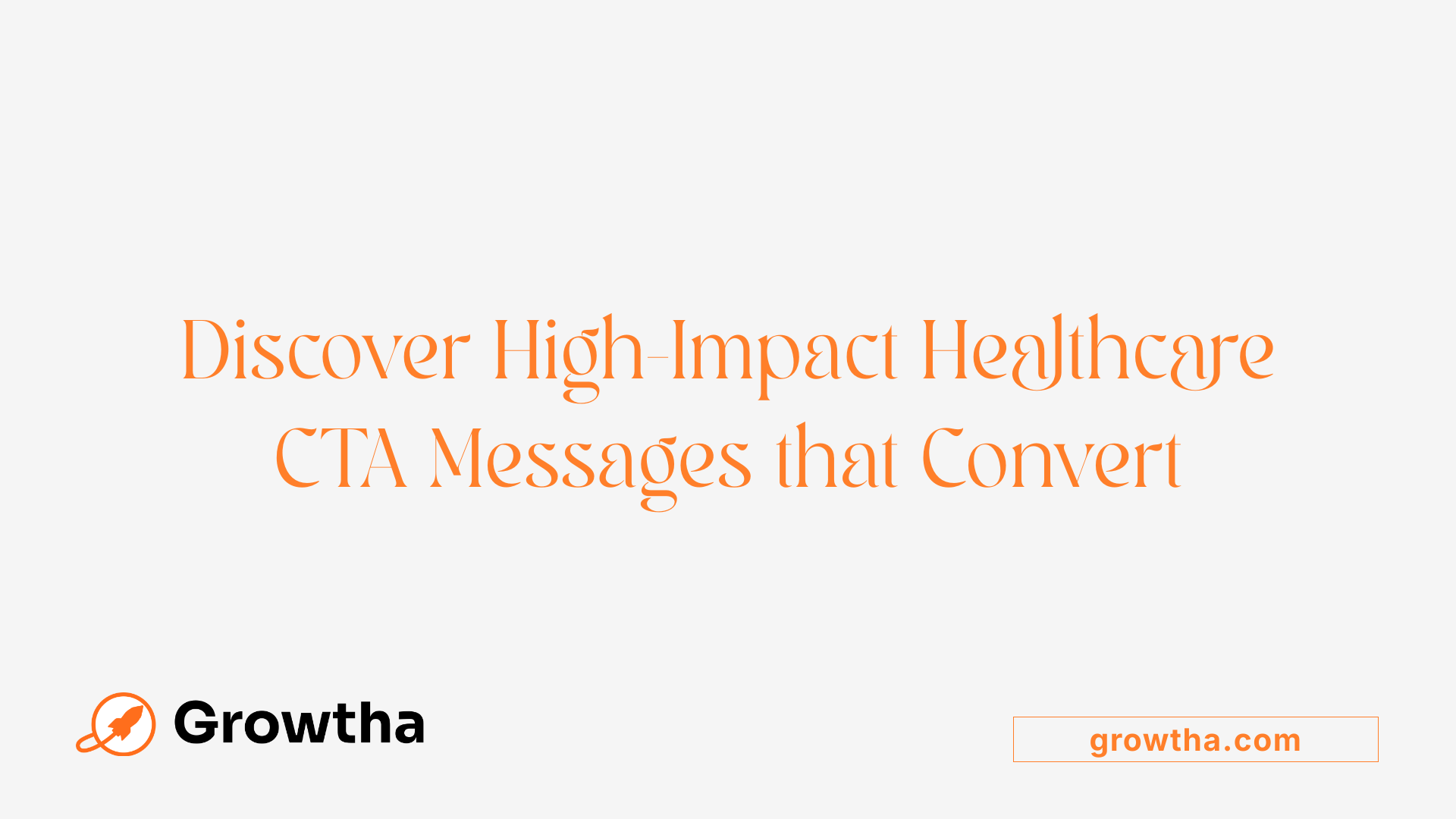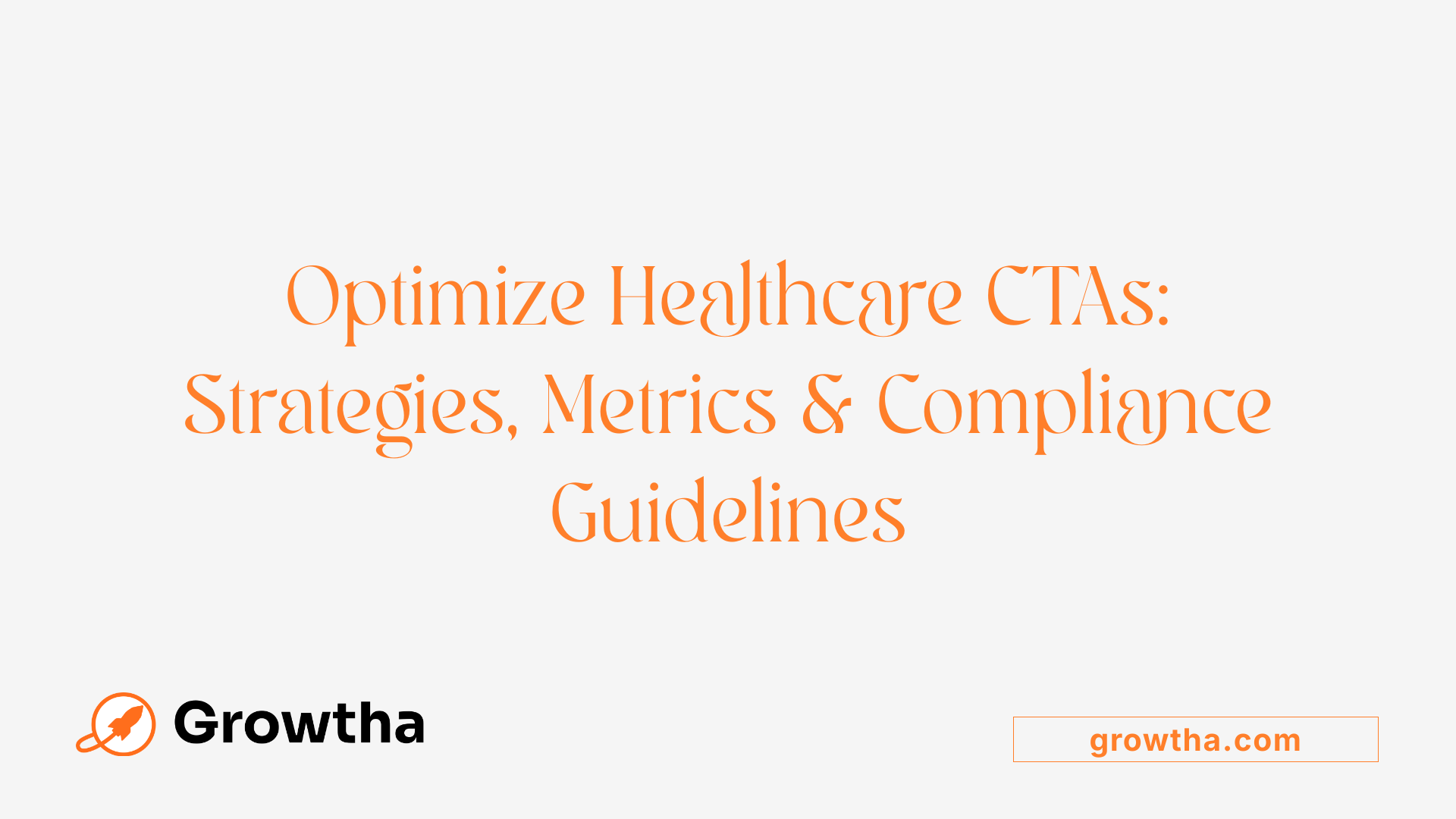Creating Effective Call-to-Actions for Medical Websites
Enhancing Patient Engagement Through Strategic CTAs


Creating Effective Call-to-Actions for Medical Websites
The Power of Well-Crafted Call-to-Actions in Healthcare Websites
Effective call-to-actions (CTAs) are essential components of healthcare websites, guiding visitors toward desired outcomes such as appointment bookings, resource downloads, or participation in wellness programs. Well-designed CTAs not only improve user experience but also significantly boost patient engagement and conversion rates. This article explores the fundamental principles, best practices, and innovative strategies to craft compelling CTAs tailored specifically to health and wellness audiences.
The Significance of Action Words in Healthcare CTAs

Why is the use of action words important in crafting effective CTAs for healthcare websites?
Using action words in healthcare website CTAs is essential because they give clear instructions to visitors, guiding them towards the next step. Phrases like "Schedule an Appointment Now," "Download Your Free Health Guide," or "Request a Second Opinion" immediately communicate what the user should do.
These words also help create a sense of urgency, encouraging users to act promptly rather than delay decision-making. When combined with benefits, such as gaining quick access to health resources or expert advice, action words motivate users to engage actively.
Furthermore, appropriate action language aligns with the user's current stage in their healthcare journey. For instance, someone seeking initial information responds well to prompts like "Learn More" whereas someone ready to commit might see "Book Now".
Effective CTAs are visually prominent, often using contrasting colors and bold fonts, and are placed strategically—typically above the fold or near relevant content—to increase visibility.
Including compelling action words not only clarifies what users should do but also makes the process feel relevant and immediate. When combined with good design and placement, these words substantially boost engagement, leading to higher conversion rates.
In conclusion, strokes of effective action words transform passive visitors into active participants by clearly telling them the next steps. This clarity, coupled with strategic placement and an empathetic tone, ensures the CTA resonates, making it a crucial element in healthcare marketing success.
Examples of High-Impact Healthcare CTA Messages
 Creating effective call-to-action (CTA) messages in healthcare websites is essential for guiding visitors towards meaningful engagement and improving service uptake.
Creating effective call-to-action (CTA) messages in healthcare websites is essential for guiding visitors towards meaningful engagement and improving service uptake.
Clear and specific messaging forms the foundation of successful CTAs. For instance, buttons labeled "Book an Appointment," "Download Patient Forms," or "Sign Up for Wellness Programs" clearly indicate the next step and the benefit for the user.
Encouraging actions that align with the patient’s journey is crucial. Tailored CTAs such as "Take the assessment" provide personalized health insights, making the action relevant and valuable. Others like "Request a second opinion" empower patients by offering additional validation of their health concerns, reinforcing the provider's authority.
Utilizing a sense of urgency and authority can significantly boost response rates. Phrases like "Reserve your spot" for seminars or workshops suggest limited availability, prompting quicker registration. Emphasizing the expertise and trustworthy nature of the provider—such as "Trusted by thousands" or "Join our expert-led webinar"—builds confidence and drives action.
To maximize impact, healthcare CTAs should be customized based on audience segments and their stage in the engagement process. For example:
| Audience Type | Sample CTA | Purpose | Visual Tips |
|---|---|---|---|
| Patients | "Schedule a Consultation" | Initial inquiry and appointment setting | Prominent button, contrasting color |
| Healthcare professionals | "Access Professional Resources" | Professional development and info | Quick links in resource sections |
| Seminar attendees | "Reserve Your Seat" | Event registration | Above the fold, countdown timers |
Practicing ongoing testing, such as A/B trials on different headlines or button designs, helps refine these messages. Tracking metrics like click-through rates and conversions allows continuous optimization.
Overall, compelling CTAs that are clear, benefit-oriented, and visually attractive—coupled with strategic placement—transform visitor interest into measurable outcomes, supporting better health engagement and service success.
Designing CTAs to Boost Patient Engagement
 Creating effective call-to-actions (CTAs) in healthcare websites requires a mix of clear messaging and strategic design. Using simple, direct language that emphasizes what the patient will gain encourages clicks. Phrases like 'Schedule an appointment' or 'Request a second opinion' should be upfront and benefit-focused.
Creating effective call-to-actions (CTAs) in healthcare websites requires a mix of clear messaging and strategic design. Using simple, direct language that emphasizes what the patient will gain encourages clicks. Phrases like 'Schedule an appointment' or 'Request a second opinion' should be upfront and benefit-focused.
Placement is also crucial. CTAs should be prominently located, often above the fold such as in headers, sidebars, or at the end of content sections. Bright, contrasting colors and bold fonts help draw immediate attention, making sure the CTA isn't missed.
Tailoring CTAs to different stages of the patient journey increases their relevance and effectiveness. Early on, softer CTAs like downloading a health guide or signing up for seminars work well. For those ready to act, stronger prompts such as 'Book Your Consultation' or 'Get Glowing Skin Now' can drive immediate responses.
Testing different approaches is vital for optimization. Techniques like A/B testing, heatmaps, and user feedback help identify what resonates best with users. Adjusting wording, color schemes, and placement based on these insights can significantly improve engagement metrics.
Lastly, commitments to privacy through secure forms and compliance with HIPAA regulations build trust. Personalizing CTAs based on user data enhances relevance, making visitors feel understood and more likely to convert.
When well-designed, these strategies transform casual website visitors into engaged patients, ultimately fostering better healthcare outcomes.
Strategies, Metrics, and Compliance for Successful CTAs

What are best practices for creating, implementing, and measuring CTAs in healthcare marketing?
Effective healthcare CTAs should be prominent, visually appealing, and clearly communicate the next step for the audience. Design elements like contrasting colors, bold fonts, and strategic placement—such as above the fold or at the end of content—help grab attention. Messaging must be concise, action-oriented, and aligned with the stage of the patient or professional journey. For example, 'Schedule an appointment' targets ready-to-act consumers, while 'Request a second opinion' empowers and builds authority.
Placement is crucial; CTAs should be strategically positioned in high-visibility areas across websites, emails, and social media. Tailoring CTAs to specific audiences—patients, healthcare professionals, or administrators—ensures relevance and increases response rates. Testing different designs, placements, and messages is essential for optimization.
Measurement techniques such as tracking click-through rates (CTR), conversion rates (CR), bounce rates, and using heatmaps provide insights into performance. A/B testing allows healthcare marketers to compare different CTA versions to determine which yields better results. Utilizing tools like heatmaps highlights where users focus their attention, informing further refinements.
In addition, personalization—leveraging patient data and preferences—can increase relevance and engagement. Calling actions should emphasize benefits or rewards, like free health assessments or limited-time booking offers, and create a sense of urgency.
Finally, compliance with HIPAA and ethical standards is vital. Using secure, encrypted forms and avoiding requests for protected health information (PHI) through CTA text maintains trust. Partnering with marketing experts ensures strategies are both effective and secure, helping to guide patients or professionals seamlessly toward desired actions.
Enhancing CTA Effectiveness Through Urgency, Clarity, and Compliance
In healthcare websites, the impact of well-crafted Call to Actions (CTAs) is profound. Among the most influential factors are urgency and clarity, which drive visitors to take immediate steps and understand exactly what is expected of them.
Urgent language like "Schedule Your Appointment Now" or "Reserve Your Spot Today" creates a sense of immediacy. This can be especially effective during health awareness months, flu seasons, or limited-time offers, where timing can motivate faster responses. Clear, benefit-oriented messages tailored to the audience's needs reduce confusion and increase engagement.
Visual prominence and strategic placement are also crucial. Using contrasting colors, bold fonts, and positioning CTAs above the fold or at key content points makes them easily noticeable. On mobile devices, large and tappable buttons ensure accessibility, helping to avoid frustration.
Healthcare compliance is paramount. CTAs must adhere to HIPAA regulations by avoiding requests for personal health information directly through the button or link, and using secure, encrypted forms. Transparency about data use, costs, or next steps fosters trust and promotes long-term patient relationships.
Building trust also involves integrating trust symbols, empathetic language, and consistent branding within CTAs. By combining urgency, clarity, visible placement, and regulatory compliance, healthcare organizations can improve response rates, deepen ties with patients, and support their overall mission of effective patient care.
Maximizing Impact with Strategic CTAs
In the competitive landscape of healthcare marketing, well-crafted CTAs are indispensable in guiding visitors through the patient journey, from initial inquiry to long-term engagement. By leveraging clear, action-oriented language, compelling design, strategic placement, and ongoing testing, healthcare providers can enhance user experience, build trust, and significantly increase conversion rates. Ensuring compliance, personalizing messages, and emphasizing immediate benefits further strengthen CTA effectiveness. Ultimately, a strategic approach to designing and measuring CTAs directly impacts patient satisfaction, organizational growth, and healthcare outcomes. Investing in continuous optimization and audience understanding is essential for long-term success.
References
- 3 CTAs to improve healthcare digital marketing ROI - WebMD Ignite
- A Call to Action: Crafting the Right CTA for Healthcare Audiences
- Make Your Healthcare Marketing CTAs Stronger - TBH Creative Blog
- A Guide to Captivating Calls to Action in Health & Wellness Marketing
- Call To Action - The CDC Clear Communication Index
- Create a Clear Call to Action on Your Functional Medicine Website
- Healthcare CTAs: Converting Clicks to Patient Care - Cured Health
- Boost Your Healthcare Practice with Effective Call to Actions
- Call-to-Action Best Practices for Medspa Websites
- 9-Point CTA Checklist for Effective Healthcare Marketing







